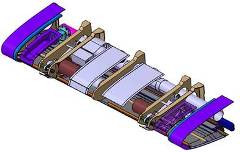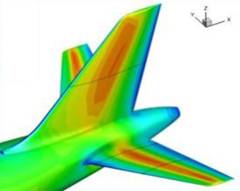HYBRID LAMINAR FLOW CONTROL (TS1)
Main expected results:
Design and structural testing of a fully integrated wing leading edge section featuring advanced HLFC technology
- Innovative WIPS for laminar wing
- Krueger flap linkage system
- Collapsible CFRP Krueger panel with folding bull nose
- Assessment of ALT device
Engineering feasibility of advanced HLFC technology applied on fin proven by means of prototype demonstration in operational environment
Progress so far:
JANUARY 2016
Following
the Design Review in February of 2015, the HLFC Wing Leading Edge ground
demonstrator has undergone extensive redesign and refinement addressing key
problems. A 150mm front spar aft shift was agreed, providing greater space for
the complex systems. The single duct solution was replaced with a resized dual
duct solution where the HLFC suction and hot air anti-ice systems are largely
separate. The Kruger and its interfaces have further matured, improving the
sealing when stowed. The super-plastic-deformation diffusion-bonded suction
skin has undergone a redesign optimising the suction chambers to mitigate
manufacturing risks while meeting aerodynamic and anti-ice requirements.
Significant effort has gone into the identification of a suitable 3D laser
drilling facility (Fraunhofer ILT), a key objective in WP1.2. Finally the DMU
has been developed to a more mature standard to the point where the manufacture
of long lead items can be launched. This was decided in a Critical Design
Review held at CIRA, Italy, in October. Further issues highlighted at this
review included structural and operability challenges to the design, which
underscore the challenge applying HLFC to the wing of a real world commercial
airliner. Questions such as the upper cover joint concept will remain part of
continued research which is being planned based on the lessons learnt thus far
in AFLoNext. Work continues to finalise the DMU, define the assembly sequence,
launch the manufacture, and plan the tests. Work on alternative skin concepts
continues, providing a more mature basis for future research.
APRIL 2015

- Maturation of the aerodynamic design of the HLFC system for the A320 VTP
- Preparation of the flight tests while defining the way to obtain the necessary permissions
- Progress on the HLFC wing leading edge
- Selection of the Krüger concept (a gooseneck folding bullnose design by Deutsches Zentrum Fuer Luft - Und Raumfahrt EV (DLR), Asco Industries N.V. (ASCO) and Innovative Verbundwerkstofferealisation Und Vermarktung Neuertechnologien GmbH (INVENT) was chosen and has since undergone significant detailed design to enable a comprehensive integration assessment in a digital mock-up).
- Sizing and development of the main systems architecture was proposed by Airbus Group Innovations (AGI) (the system currently combines the hot air anti-ice system and HLFC suction systems which use a single trunk duct which runs the length of the leading edge).
- Studies on the super-plastic-deformed skin which incorporates a series of chambers to enable either suction or ant-ice functionality by the Societe Nationale De Construction Aerospatiale SA (SONACA)
JULY 2014

- Definition of the requirements for a simplified HLFC system for the A320 VTP.
- Definition of the final chamber layout of the system through ongoing computations with respect to the cases for the relevant side slip angles, rudder deflection angles and HTP setting angles.
- Start of aerodynamics working with preliminary pressure distribution to define the surface smoothness requirements.
- Initial design phase reached by completion of the preliminary design of the monitoring and measuring system.
- Start of the application of simplified HLFC to the leading edge of a wing.
- Finalizaton of the initial geometry for an outer wing of a long-range aircraft.
- Start of the design of a combined suction and de-icing system which respects the space allocation requirements for the Krueger high-lift system has started.
- In terms of the high-lift system, development of two Krueger systems with the same aero requirements but different kinematics:one of the Krueger systems will be selected and further developed within the project.
JANUARY 2014
The work on the HLFC fin has concentrated on the following items:
- First definition of the flight envelope for the HLFC system.
- Start of the design process based on a preliminary geometry of the A320 VTP and on the chamber layout for the two HLFC leading edges which will be tested within the German national HIGHER project in 2014.
- First issue of the surface quality requirements document.
- Start of compiling the requirements to obtain the “permit to fly.”
- Setting up a group to prepare of the flight test with the A320 ATRA aircraft.
Main HLFC wing activities have been:
- Definition of a wing geometry representative for an outer wing of a long-range transport aircraft.
- Agreement between aerodynamics and structures on the design process and set up of a digital mock-up.
- Start of the work on the three different HLFC surface concepts:
(a) based on superplastic forming,
(b) based on a perforated porous composite with metallic erosion shield, and
(c) based on metallic foam.
- Start of the space allocation study for Krueger flaps including two different deployment systems.


